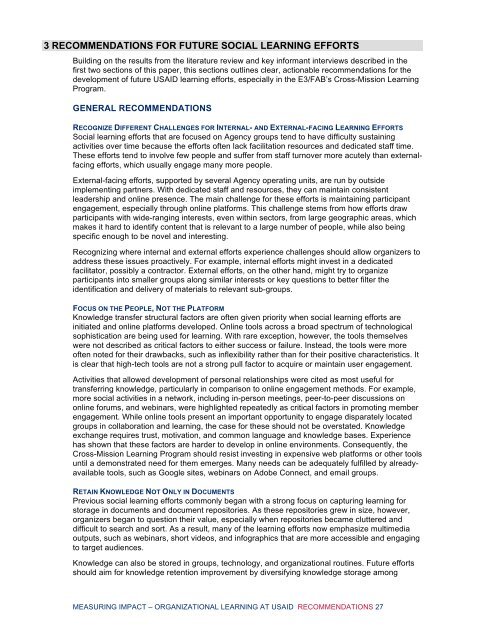MEASURING IMPACT Making Use of the Portfolio Organizational Learning at USAID
28Mzh2D
28Mzh2D
Create successful ePaper yourself
Turn your PDF publications into a flip-book with our unique Google optimized e-Paper software.
3 RECOMMENDATIONS FOR FUTURE SOCIAL LEARNING EFFORTS<br />
Building on <strong>the</strong> results from <strong>the</strong> liter<strong>at</strong>ure review and key informant interviews described in <strong>the</strong><br />
first two sections <strong>of</strong> this paper, this sections outlines clear, actionable recommend<strong>at</strong>ions for <strong>the</strong><br />
development <strong>of</strong> future <strong>USAID</strong> learning efforts, especially in <strong>the</strong> E3/FAB’s Cross-Mission <strong>Learning</strong><br />
Program.<br />
GENERAL RECOMMENDATIONS<br />
RECOGNIZE DIFFERENT CHALLENGES FOR INTERNAL- AND EXTERNAL-FACING LEARNING EFFORTS<br />
Social learning efforts th<strong>at</strong> are focused on Agency groups tend to have difficulty sustaining<br />
activities over time because <strong>the</strong> efforts <strong>of</strong>ten lack facilit<strong>at</strong>ion resources and dedic<strong>at</strong>ed staff time.<br />
These efforts tend to involve few people and suffer from staff turnover more acutely than externalfacing<br />
efforts, which usually engage many more people.<br />
External-facing efforts, supported by several Agency oper<strong>at</strong>ing units, are run by outside<br />
implementing partners. With dedic<strong>at</strong>ed staff and resources, <strong>the</strong>y can maintain consistent<br />
leadership and online presence. The main challenge for <strong>the</strong>se efforts is maintaining participant<br />
engagement, especially through online pl<strong>at</strong>forms. This challenge stems from how efforts draw<br />
participants with wide-ranging interests, even within sectors, from large geographic areas, which<br />
makes it hard to identify content th<strong>at</strong> is relevant to a large number <strong>of</strong> people, while also being<br />
specific enough to be novel and interesting.<br />
Recognizing where internal and external efforts experience challenges should allow organizers to<br />
address <strong>the</strong>se issues proactively. For example, internal efforts might invest in a dedic<strong>at</strong>ed<br />
facilit<strong>at</strong>or, possibly a contractor. External efforts, on <strong>the</strong> o<strong>the</strong>r hand, might try to organize<br />
participants into smaller groups along similar interests or key questions to better filter <strong>the</strong><br />
identific<strong>at</strong>ion and delivery <strong>of</strong> m<strong>at</strong>erials to relevant sub-groups.<br />
FOCUS ON THE PEOPLE, NOT THE PLATFORM<br />
Knowledge transfer structural factors are <strong>of</strong>ten given priority when social learning efforts are<br />
initi<strong>at</strong>ed and online pl<strong>at</strong>forms developed. Online tools across a broad spectrum <strong>of</strong> technological<br />
sophistic<strong>at</strong>ion are being used for learning. With rare exception, however, <strong>the</strong> tools <strong>the</strong>mselves<br />
were not described as critical factors to ei<strong>the</strong>r success or failure. Instead, <strong>the</strong> tools were more<br />
<strong>of</strong>ten noted for <strong>the</strong>ir drawbacks, such as inflexibility ra<strong>the</strong>r than for <strong>the</strong>ir positive characteristics. It<br />
is clear th<strong>at</strong> high-tech tools are not a strong pull factor to acquire or maintain user engagement.<br />
Activities th<strong>at</strong> allowed development <strong>of</strong> personal rel<strong>at</strong>ionships were cited as most useful for<br />
transferring knowledge, particularly in comparison to online engagement methods. For example,<br />
more social activities in a network, including in-person meetings, peer-to-peer discussions on<br />
online forums, and webinars, were highlighted repe<strong>at</strong>edly as critical factors in promoting member<br />
engagement. While online tools present an important opportunity to engage dispar<strong>at</strong>ely loc<strong>at</strong>ed<br />
groups in collabor<strong>at</strong>ion and learning, <strong>the</strong> case for <strong>the</strong>se should not be overst<strong>at</strong>ed. Knowledge<br />
exchange requires trust, motiv<strong>at</strong>ion, and common language and knowledge bases. Experience<br />
has shown th<strong>at</strong> <strong>the</strong>se factors are harder to develop in online environments. Consequently, <strong>the</strong><br />
Cross-Mission <strong>Learning</strong> Program should resist investing in expensive web pl<strong>at</strong>forms or o<strong>the</strong>r tools<br />
until a demonstr<strong>at</strong>ed need for <strong>the</strong>m emerges. Many needs can be adequ<strong>at</strong>ely fulfilled by alreadyavailable<br />
tools, such as Google sites, webinars on Adobe Connect, and email groups.<br />
RETAIN KNOWLEDGE NOT ONLY IN DOCUMENTS<br />
Previous social learning efforts commonly began with a strong focus on capturing learning for<br />
storage in documents and document repositories. As <strong>the</strong>se repositories grew in size, however,<br />
organizers began to question <strong>the</strong>ir value, especially when repositories became cluttered and<br />
difficult to search and sort. As a result, many <strong>of</strong> <strong>the</strong> learning efforts now emphasize multimedia<br />
outputs, such as webinars, short videos, and infographics th<strong>at</strong> are more accessible and engaging<br />
to target audiences.<br />
Knowledge can also be stored in groups, technology, and organiz<strong>at</strong>ional routines. Future efforts<br />
should aim for knowledge retention improvement by diversifying knowledge storage among<br />
<strong>MEASURING</strong> <strong>IMPACT</strong> – ORGANIZATIONAL LEARNING AT <strong>USAID</strong> RECOMMENDATIONS 27


